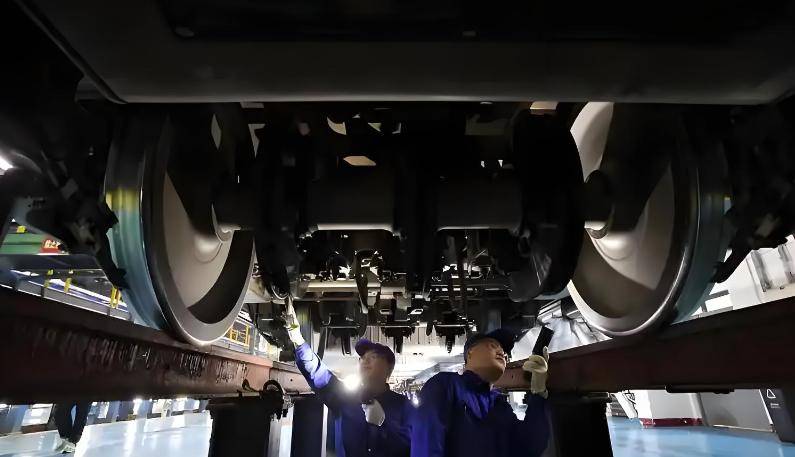Want to know more?
Don't miss any product updates on our industrial borescopes

Industrial borescope
solution service provider
Company Address
Office : 18F, Pingshanshouzuo, Pingshan District, Shenzhen,Guangdong
Contact Info
Ph: +86-0755-89588241

Industrial endoscopes play a vital role in train maintenance, and their application runs through many key links in railway transportation equipment inspection. The following is a detailed analysis of specific application scenarios, technical advantages and typical cases:
Inner defect detection of rails
Application method: Insert the endoscope probe into the rails through a specific inspection hole, and use high-definition lenses (some models reach millions of pixels) and LED lighting systems to visually observe hidden defects such as cracks, disconnections, and deformations.
Advantages: Break through the limitations of traditional naked eye inspections, achieve "visualization" of the internal state of the rails, and significantly improve the accuracy of defect identification.
Screening of hidden defects in wheels
Application method: Go deep into the wheel to detect tiny cracks (the minimum identifiable defect is 0.02mm) and internal damage that are difficult to detect with traditional ultrasonic flaw detection.
Case: After a railway bureau used endoscopes, the detection rate of wheel faults increased by 40%, and emergency braking events caused by wheel hidden dangers decreased by 65%.
Inspection of key components of locomotives
Gearbox: insert an endoscope through the oil observation port to check gear wear, poor engagement and foreign matter at the bottom of the box to avoid the risk of gearbox scrapping.
Traction motor: use the maintenance window or cooling hole to observe internal oil stains, carbon deposits, bearing wear and lead status to reduce disassembly inspection time.
Hollow shaft: combined with the results of ultrasonic flaw detection, magnify the suspicious parts by more than 35 times to accurately measure parameters such as crack length and depth.
Brake system fault location
Application: use an endoscope at complex bends in the brake pipe system to quickly locate foreign matter stuck (such as rust accumulated in the brake air cylinder).
Efficiency improvement: after a certain EMU adopts an endoscope, the troubleshooting time of the brake system is shortened by 70%, and the maintenance time of a single EMU during the Spring Festival travel rush is shortened from 2 hours to 45 minutes.
High-definition imaging and data analysis
Function: equipped with direct/side-view dual-million high-definition cameras, supporting real-time dual-view display on the same screen, and defect images can be stored and remotely diagnosed.
Case: Shenzhen VSNDT endoscope realizes 360° all-round image guidance in railway inspection, and the inspection efficiency of complex structural parts is improved by 50%.
Portability and non-destructive inspection
Design: Handheld design, light weight (some models are only 0.8kg), suitable for complex environments such as high altitude and field.
Value: Natural pore inspection can be performed without disassembling the equipment, avoiding secondary damage to the equipment by traditional inspection.
Multi-function integration
Measurement function: Supports quantitative analysis of length, area, depth, etc., and some models are equipped with three-dimensional measurement technology.
Recording and re-inspection: On-site video/photography archiving, support computer-side re-inspection and defect tracking, forming a closed loop of inspection archives.
Railway gearbox inspection
Scenario: A locomotive depot uses an industrial endoscope to inspect the gearbox of a Harmony locomotive, discovers early signs of gear cracks, and avoids derailment accidents.
Data: The inspection time is shortened to 1/3 of the traditional method, and the fault misjudgment rate is reduced to less than 0.5%.
Cleanliness detection of brake cylinder of EMU
Method: Observe the dust accumulation inside the cylinder through endoscope to guide the optimization of dust blowing operation parameters.
Effect: The failure rate of the brake system decreased by 30%, and the cleaning cycle of the cylinder was extended by 50%.
Detection of hidden structures in bridges and tunnels
Extended application: In railway infrastructure, endoscopes are used to check hidden defects such as internal rust of bridge bearings and voids in tunnel linings to ensure structural safety.

Industrial endoscopes have significantly improved the accuracy and efficiency of train maintenance through the "visual detection + quantitative analysis" mode, which is specifically reflected in:
Safety guarantee: Discover hidden defects of key components such as rails and wheels in advance to reduce the risk of major accidents.
Cost optimization: Reduce unplanned downtime, extend equipment service life, and reduce maintenance costs by 20%-30%.
Intelligent upgrade: Combined with remote diagnosis, AI image recognition and other technologies, promote the transformation of railway maintenance to digital and predictive maintenance.
With the iteration of technology, the application scenarios of industrial endoscopes in train maintenance will continue to expand, becoming an indispensable "third eye" for safe railway operations.

Industrial borescope
solution service provider